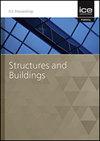Limit state design of resilient earthquake resisting systems
IF 1.4
4区 工程技术
Q3 CONSTRUCTION & BUILDING TECHNOLOGY
Proceedings of the Institution of Civil Engineers-Structures and Buildings
Pub Date : 2023-05-04
DOI:10.1680/jstbu.22.00202
引用次数: 0
Abstract
Sustainable Seismic Design (SSD) is the first step toward next-generation earthquake engineering. SSD of Mixed Multiple Seismic Systems (MMSS), where more than one earthquake-resisting structure (ERS) are used, is one of the challenging structural engineering issues. Seismic Sustainability (SS) implies survivability during and after the earthquake, preceded by Post-Earthquake Realignment and Repairs (PERR). Purpose-specific MMSS are ideally suited for SSD. However, contemporary codes address neither sequences nor failure mechanisms of the earthquake-resisting structures of MMSS. The difference between conventional design and SSD is their approach to expected behavior during and after earthquakes. Earthquakes are, natural and dynamic occurrences, whereas PERR is a manual and static process. SSD does not favor unreal detailing nor oversimplifying assumptions; it is a multifaceted effort that involves realistic structural analysis and planned manual operations. In this context, design implies operability with a view to PERR and requires a change from damageability assessment, and Performance-Based Seismic Design (PBSD), to Performance Control (PC) and Reparability Based Design (RBD), including development of new analytic tools and purpose-specific details. The current paper presents graphical solutions and theoretical principles that help achieve practical SSD for MMSS. These new techniques may be utilized for practical reliability, economy, and environmental protection.弹性抗震体系的极限状态设计
可持续地震设计(SSD)是迈向下一代地震工程的第一步。混合多地震系统(MMSS)的SSD是一个具有挑战性的结构工程问题,其中使用了多个抗震结构(ERS)。地震可持续性(SS)指地震期间和地震后的生存能力,在地震后的调整和修复(PERR)之前。特定用途的MMSS非常适合SSD。然而,目前的规范既没有解决mss抗震结构的序列问题,也没有解决mss抗震结构的破坏机制。传统设计和SSD之间的区别在于它们对地震期间和地震后预期行为的方法。地震是自然和动态的事件,而PERR是一个人工和静态的过程。SSD不喜欢不真实的细节,也不喜欢过度简化的假设;这是一个多方面的工作,包括实际的结构分析和计划的手工操作。在这种情况下,设计意味着从PERR角度出发的可操作性,需要从易损性评估和基于性能的地震设计(PBSD)转变为性能控制(PC)和基于可修复性的设计(RBD),包括开发新的分析工具和特定用途的细节。本文提出了图形化解决方案和理论原理,有助于实现实用的MMSS固态硬盘。这些新技术在可靠性、经济性和环保性方面具有实际应用价值。
本文章由计算机程序翻译,如有差异,请以英文原文为准。
求助全文
约1分钟内获得全文
求助全文
来源期刊
CiteScore
3.40
自引率
6.20%
发文量
61
审稿时长
12 months
期刊介绍:
Structures and Buildings publishes peer-reviewed papers on the design and construction of civil engineering structures and the applied research associated with such activities. Topics include the design, strength, durability and behaviour of structural components and systems.
Topics covered: energy conservation, people movement within and around buildings, strength and durability of steel and concrete structural components, and the behaviour of building and bridge components and systems

 求助内容:
求助内容: 应助结果提醒方式:
应助结果提醒方式:


